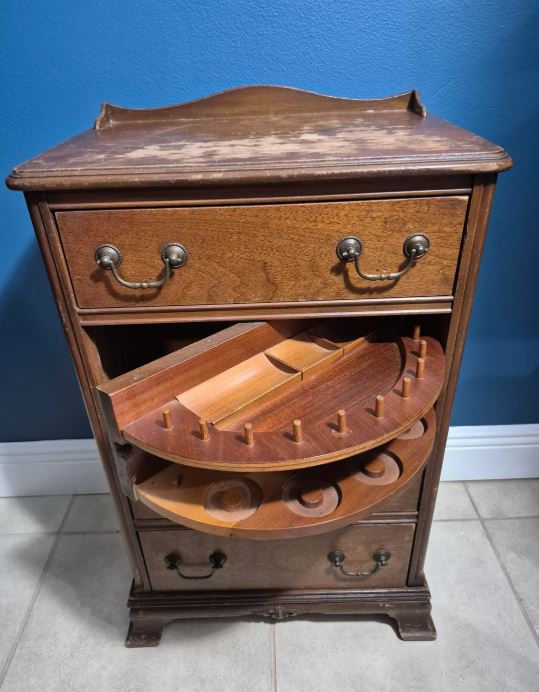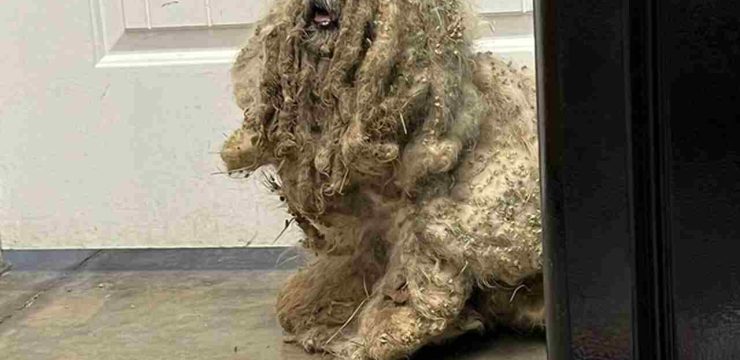I was wandering through a charming little antique shop, the kind that smells faintly of old wood and hidden stories, when I stumbled into a dim, slightly musty back room and saw it—an adorable vintage sewing cabinet. I wasn’t looking for one, not even close. I don’t sew unless you count frantically reattaching a button before work as “sewing.”

But something about it pulled me in. I opened the front doors, and my jaw practically dropped. Inside were tiny wooden pegs for thread spools, little secret drawers, and spinning shelves—it was like a miniature clubhouse for sewing enthusiasts. In that moment, I knew I had to take it home, even though the only thing I could reliably stitch was a loose hem in a state of mild panic. Back in the day, these sewing cabinets were far more than furniture. As I later learned from chatting with other collectors, they were essential household tools. For decades, a well-crafted cabinet like this was the command center for home crafters.
People made everything—clothes, curtains, costumes—long before “DIY” was a buzzword. You didn’t need hot glue guns or Pinterest tutorials; you just needed a sturdy sewing station and some skill. Moms, grandmas, and even a few dads kept these cabinets in the living room or tucked neatly into a bedroom corner, everything organized and ready for the next project. The magic of these cabinets lies in their design, which you only appreciate when you start exploring. Mine has revolving shelves lined with wooden pegs to hold thread spools upright in perfect rows—an oddly satisfying sight.
There’s a tiny tray just big enough for scissors, needles, and other sharp little tools that I’d usually lose in my junk drawer. The bottom has circular holders, probably meant for jars of buttons or bobbins, though mine now holds a random assortment of old keys I can’t match to any lock. Every detail feels intentional, built for purpose, not just slapped together from cheap plastic. And the build quality? Incredible. This cabinet is solid wood, no wobbly legs, no particleboard pretending to be something sturdier.
The chunky brass handles look like they could survive an apocalypse. Sure, the top has some scratches, a ding or two, and a few scuffs, but that’s part of the charm. Those imperfections tell a story—a life of hems repaired, costumes stitched, maybe even a wedding dress sewn with love and care. I’ll be honest: I don’t actually use it for sewing. Not often, anyway. Shoutout to my dry cleaner for keeping me presentable. Instead, I’ve repurposed mine as a quirky little side table. The top is perfect for holding my coffee mug, the middle shelves swing out for coasters and phone chargers, and the bottom drawer?
That’s my snack stash—don’t judge. And I’m not alone in thinking beyond its original purpose. Plenty of people are repurposing these vintage gems into liquor cabinets, art supply stations, or mini tool chests. Of course, if you do sew, they’re still perfect for their intended job, but their versatility makes them irresistible even to those of us who don’t know a bobbin from a thimble. What I love most, though, is the feeling this cabinet gives me. It’s soothing in a way I can’t quite explain. Maybe it’s nostalgia. Maybe it’s the uniqueness—this isn’t a mass-produced piece you can pick up at a big-box store. It’s a quiet rebellion against the fast-fashion, fast-furniture, fast-everything culture. When I open one of those tiny spinning shelves, I think about the person who owned it before me, about what they made, and about the stories woven into the fabric that might have once been stored there.
So, should you get one? Absolutely. If you spot a vintage sewing cabinet at a flea market, estate sale, thrift store, or tucked in the corner of an antique shop, don’t hesitate. Whether you sew or not, it’s a functional, charming piece of history. And once you own one, something funny happens—you start seeing them everywhere, like you’ve joined a secret club of people who appreciate things built to last. It’s more than just a piece of furniture; it’s a little piece of the past, quietly keeping its place in the present, ready to be useful and loved all over again.





